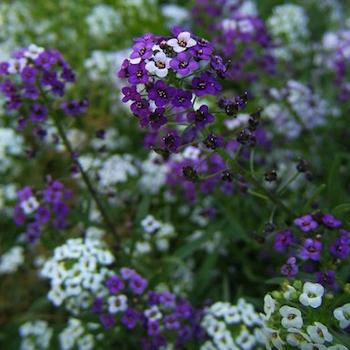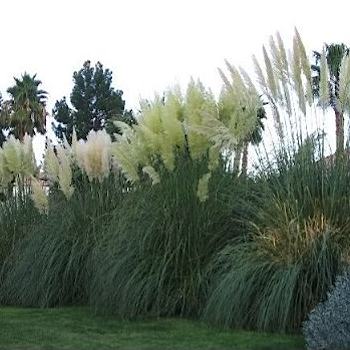Grass Alternatives
The vision of one's home surrounded by an oasis of lush green grass is an enticing one. But the cost of maintaining that vision is high; environmental costs like mower emissions, toxic fertilizers and pesticides, and large amounts of water.
The more personal costs of lawn maintenance in the form of time and money take their toll as well. How many perfectly good Saturday afternoons need to be squandered pushing a mower around the yard before we decide enough is enough?
Reducing (or even eliminating) the size of your grass lawn benefits the environment and saves you precious time and money. There are lots of grass alternatives that can help you achieve a beautiful yard full of color and variety.
Let's take a look at some of the choices you have to make your lawn more environmentally sustainable while reducing the time and money necessary to maintain it.
Grass Alternatives - Groundcovers
Despite the environmental problems associated with a traditional lawn, many people enjoy the look and feel of a grass lawn, and the welcoming space it creates for the family.
Groundcover plants spread out over your yard but do not grow very tall, eliminating the need for mowing. Groundcover plants also require very little maintenance. Groundcovers can enhance a soil's quality by fixing nitrogen, and are available in a wide variety of textures, densities, and colors. Most groundcovers are perennials, eliminating the need to replant each spring.
Some groundcovers, such as stawberries and low-growing herbs, are edible. Strawberry plants produce delicious fruits during the summer and can tolerate poor soils. Herbs like thyme and oregano are excellent edible groundcovers for smaller areas.
Other types of groundcovers are alyssum, tapien, cotoneaster, juniper, and bishops weed.
Groundcovers will need weeding and mulching during their first year, but will require little maintenance once they're established.
Groundcovers typically will need an edging barrier to contain them. These edgings can be brick or wood, or any other type of edging that penetrates a few inches into the soil.
Grass Alternatives - Clover
Clover is a fast-growing plant, and is often considered a weed in a grass lawn. Instead of fighting it as a weed, consider using it as your primary turf replacement, it's got a lot going for it:
- Super Low Maintenance: clover doesn't need water or mowing.
- Fertilizer Free: Clover thrives without the need for fertilizer, chemical or natural.
- Green Color: Clover will stay green even in drought conditions.
- Inexpensive: Clover is cheap; about $4 will cover 4000 square feet of lawn.
- Softness: Clover is soft and easy on the feet, although it's not quite as durable as grass.
Take it from us: Clover is a super grass replacement. It's far easier to let it spread on your lawn than it is to try to kill it will toxic pesticides. Also from personal experience: clover tolerates dog urine much better than grass!
Some common varieties of clover are Dutch White, Yellow Blossom, and Red Clover. Dutch White clover is preferred for lawn usage, as it grows shorter (4 to 8") , it acts as a natural fertilizer, and will grow well in poor soils such as clay.
Lawn Alternatives - Ornamental Grasses
To reduce your lawn size, you can convert part of the lawn into a display of ornamental grasses. Ornamental grasses are low maintenance and grow well in all types of soils. These grasses require little if any fertilizer and water, and don't have many issues with pests or disease.
Some types of ornamental grasses are:
- Running-growth habit: These grasses range from slow creepers to aggressive spreading, and are good for erosion control on slopes, or as a groundcover.
- Clumping-growth habit: These ornamental grasses grow in tufts, and their attractive appearance makes them popular in gardens.
- Ornamental grasses prefer a sunny location, generous spacing, and water when they're getting established. Ornamental grasses can be cut back each spring for new growth.
Grass Alternatives - Flower & Shrub Beds
Flower and shrub beds can be used to reduce the mowing size of your grass lawn and increase the low maintenance areas of your yard. For hilly areas that are difficult to mow, terraced beds are an excellent solution. Beds can also be installed beneath trees with low branches or protruding roofs, which can often cause mowing difficulties.
Here's a few suggestions for building and placing flower and shrub beds:
Go Local: Native perennial plants will require the least amount of maintenance. Perennials may require dividing and splitting as they grow, which doesn't take much time, and the divided sections make great gifts to friends or neighbors.
Go Low-Maintenance: Look for plant varieties that don't need to be pruned or divided regularly. The idea is to save you time, not make more work.
Mulch: Spread at least 2 inches of mulch around the base of new plants. This will save water and keep the soil aerated. Common materials for mulching include grass clippings, bark, sawdust or straw.
Consult with a nursery in your local area for information on the best native perennials and lowest maintenance plants.
Plant Raised Beds: A raised bed not only highlights your beautiful plants, it also provides a barrier from the lawn, deters ground pests, and controls soil erosion.
Grass Alternatives - The Shape of Lawns to Come
Did you know that something as simple as the basic shape of your lawn itself can affect the amount of time and effort necessary to maintain it? It's true. Here are some tips to cut down on your lawn maintenance by designing your lawn with lots of continuous, easy-to-mow lines.
- Cut the Corners: Eliminating corners makes mowing much quicker and easier. Replace corners with shrub or flower beds. Less mowing equals less time wasted and less pollution. Designed the right way, replacing 25% of a lawn's original area can reduce grass cutting time by as much as 50%.
- Lawn Islands: "Islands" in a lawn, whether a large tree or a flower or landscaped bed, can slow the mowing down quite a bit. It's more efficient to have one or two larger islands than several smaller ones to mow around.
- Trees: Trees in your yard add beauty and natural habitats to your yard, but can really add to lawn care time and effort. Trees with low-hanging branches or roots coming out of the ground can have groundcover plants, mulch, or beds of native plants around their base to eliminate the need to mow under them. A brick or flagstone border can be used as edging; setting the border at or below the level of the lawn makes mowing easy and eliminates the need for trimming.
Whether you've got an existing lawn or are planning a brand new one, some creative planning and planting can help give you the best of both worlds: a beautifully landscaped yard that is also low-maintenance and easy on the environment.
comments powered by Disqus





































































